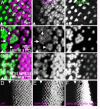Notch activity opposes Ras-induced differentiation during the Second Mitotic Wave of the developing Drosophila eye
- PMID: 16504047
- PMCID: PMC1420272
- DOI: 10.1186/1471-213X-6-8
Notch activity opposes Ras-induced differentiation during the Second Mitotic Wave of the developing Drosophila eye
Abstract
Background: EGF receptor acts through Ras and the MAPK cascade to trigger differentiation and maintain survival of most of cell types in the Drosophila retina. Cell types are specified sequentially by separate episodes of EGFR activity. All the cell types differentiate in G1 phase of the cell cycle. Before differentiating, many cells pass through the cell cycle in the "Second Mitotic Wave" in response to Notch activity, but no cell fates are specified during the Second Mitotic Wave. It is not known how fate specification is limited to G1-arrested cells.
Results: Competence to differentiate in response to activated RasV12 was diminished during the Second Mitotic Wave accounting for the failure to recruit cell fates from cycling cells. Competence was not restored by blocking cell cycle progression, but was restored by reduced Notch activity.
Conclusion: Competence to differentiate does not depend on cell cycle progression per se, but on the same receptor activity that also induces cell cycle entry. Dual effects of Notch on the cell cycle and on differentiation help ensure that only G1 phase cells undergo fate specification.
Figures





Similar articles
-
The Notch pathway regulates the Second Mitotic Wave cell cycle independently of bHLH proteins.Dev Biol. 2017 Nov 15;431(2):309-320. doi: 10.1016/j.ydbio.2017.08.035. Epub 2017 Sep 14. Dev Biol. 2017. PMID: 28919436 Free PMC article.
-
Combinatorial signaling in the specification of primary pigment cells in the Drosophila eye.Development. 2007 Mar;134(5):825-31. doi: 10.1242/dev.02788. Epub 2007 Jan 24. Development. 2007. PMID: 17251265
-
Parsimony and complexity: Cell fate assignment in the developing Drosophila eye.Fly (Austin). 2017 Jul 3;11(3):171-178. doi: 10.1080/19336934.2017.1291103. Epub 2017 Feb 6. Fly (Austin). 2017. PMID: 28165886 Free PMC article.
-
The little R cell that could.Int J Dev Biol. 2004;48(8-9):755-60. doi: 10.1387/ijdb.041881rn. Int J Dev Biol. 2004. PMID: 15558468 Review.
-
NOTCH and the patterning of ommatidial founder cells in the developing Drosophila eye.Results Probl Cell Differ. 2002;37:35-58. doi: 10.1007/978-3-540-45398-7_4. Results Probl Cell Differ. 2002. PMID: 25707068 Review. No abstract available.
Cited by
-
Impact of steroid hormone signals on Drosophila cell cycle during development.Cell Div. 2009 Jan 20;4:3. doi: 10.1186/1747-1028-4-3. Cell Div. 2009. PMID: 19154610 Free PMC article.
-
Generating patterned arrays of photoreceptors.Curr Opin Genet Dev. 2007 Aug;17(4):314-9. doi: 10.1016/j.gde.2007.05.003. Epub 2007 Jul 5. Curr Opin Genet Dev. 2007. PMID: 17616388 Free PMC article. Review.
-
Interplay between sex determination cascade and major signaling pathways during Drosophila eye development: Perspectives for future research.Dev Biol. 2021 Aug;476:41-52. doi: 10.1016/j.ydbio.2021.03.005. Epub 2021 Mar 18. Dev Biol. 2021. PMID: 33745943 Free PMC article. Review.
-
Antagonistic regulation of the second mitotic wave by Eyes absent-Sine oculis and Combgap coordinates proliferation and specification in the Drosophila retina.Development. 2017 Jul 15;144(14):2640-2651. doi: 10.1242/dev.147231. Epub 2017 Jun 15. Development. 2017. PMID: 28619818 Free PMC article.
-
Polarized secretion of Drosophila EGFR ligand from photoreceptor neurons is controlled by ER localization of the ligand-processing machinery.PLoS Biol. 2010 Oct 5;8(10):e1000505. doi: 10.1371/journal.pbio.1000505. PLoS Biol. 2010. PMID: 20957186 Free PMC article.
References
-
- Yang L, Baker NE. Role of the EGFR/Ras/Raf pathway in specification of photoreceptor cells in the Drosophila retina. Development. 2001;128:1183–1191. - PubMed
Publication types
MeSH terms
Substances
Grants and funding
LinkOut - more resources
Full Text Sources
Molecular Biology Databases
Research Materials
Miscellaneous

